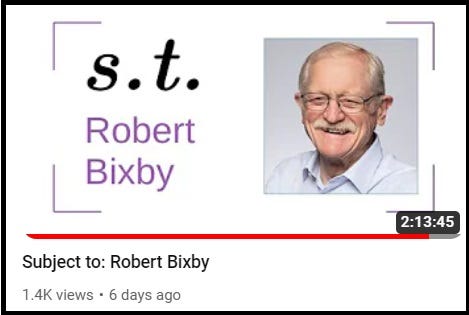Great s.t. interview with Bob Bixby and Inspiration for a Book Someone Should Write
I enjoyed this podcast. It also gave me an idea for a book someone should write.
Before I talk about the book, here are some thoughts on the podcast.
I was pre-disposed to like this podcast. Bob (and CPLEX) was at ILOG when they bought LogicTools. The podcast mentioned people I knew; I was in grad school with his daughter; and I’ve worked with Gurobi over the years.
On top of that, Bob is a great storyteller and a straight shooter— he’ll say when he messed up and did something great. Anand, the podcast host, is a great interviewer— he prepared thoroughly and used his questions sparingly to let Bob tell his story.
I might do another post with ten highlights from the interview, but here are two:
CPLEX was a great business and a cash machine. I saw this first-hand when LogicTools was acquired by ILOG. I thought LogicTools had a great business, but when I was on the inside and saw CPLEX, it seemed perfect. In the Podcast, Bob mentioned that CPLEX revenues were less than $40M with more than $12M profits.
Having a better product doesn’t mean you can sell it. In the early CPLEX days, their linear programming solver was 40X faster than the current tool offered by IBM. But, the airlines (the big buyers of this back then) wouldn’t buy it because overnight runs were fine. This only changed when two airlines merged, and they needed to run multiple scenarios a day.
Now to the book idea.
I’ve always thought a pop science book could be written about optimization and operations research. I know the World War II stories are out there. But can’t this field's modern wonders and achievements make it to the general population?
I never had a hook until listening to this interview. Now I have two.
The first hook is to tie optimization to AI. Bob knows cases where the optimization runs in real-time, and the output is automatically implemented. He said, “If that isn’t AI, I don’t know what AI is.”
The second hook comes from the drama of CPLEX.
CPLEX has a good origin story. It was founded accidentally. It was a bet on an underdog technology. At the time and for many years, better technologies were on the market. It took some lucky breaks to keep improving it.
There is a dramatic breakthrough that took months of hard work: CPLEX 6.5 (in 98/99) made a 10X breakthrough in speed by combing through years of academic papers and software engineering.
And, there is a perfect “a computer can’t pass the Turing Test before ChatGPT” kind of moment: Shortly after 6.5 came out, Bob was at an energy conference where an academic researcher was talking about a problem with 50,000 variables where it was impossible even to solve smaller versions. Bob rushed around all day to get his hands on the problem, solved it in 20 minutes that night, and presented it the next day. From then on, mixed integer programming took off as a general-purpose technology.
There are a lot of details to work out, including how to visualize the complexity of this technology. I would love to help readers visualize the technology with an analogy to LLMs.
I’ve heard you should write the book you want to read. I’ll be jealous if you beat me to it. But I’ve put it out here for you to take because I might not get to it or be the best person to write it.



You should write it.
Lance Fortnow's book did pretty well (link below). The CPLEX/MIP story would be even more accessible.
https://www.amazon.com/Golden-Ticket-NP-Search-Impossible/dp/0691175780
I can introduce you to Lance if you want. I think he remembers me.
Hello Mike:
I think if there is someone qualified to write a book like this is you!. Looking forward on what I can learn from it!!!